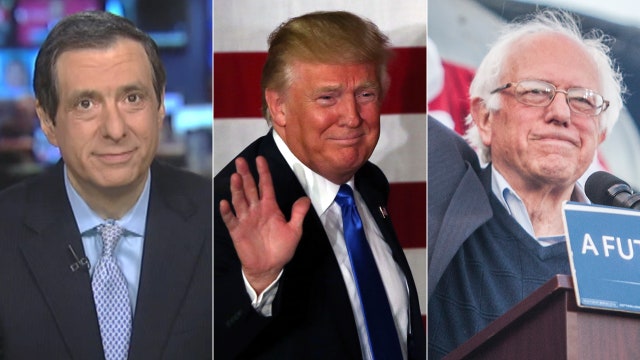Kurtz: Donald and Bernie, strange bedfellows
'MediaBuzz' host on whether Trump can actually win over Sanders supporters
One of the strangest questions in politics is whether disaffected Bernie backers might wind up on the Trump train.
It scrambles all the usual Beltway assumptions on left-right politics. After all, how could diehard supporters of Bernie Sanders—who’s so far left that he’s unhappy with eight years of Obama liberalism—move to a Republican who wants to build a wall on the Mexican border and temporarily bar Muslim immigrants?
Part of the answer is that the electorate has changed. And part is that voters don’t operate the way pundits do, with an issue-by-issue checklist that requires ideological consistency.
Trump rails against a rigged system. Sanders rails against a rigged system. Trump even says the Democratic Party is screwing Bernie and, in a bit of mischief-making, urges him to run as an independent.
They both tee off on unfair trade deals and play to middle-class economic anxieties. That populist approach touches a nerve far more than a bunch of carefully worded position papers.
“A lot of those people would come with me,” Trump said of Sanders supporters yesterday on “Fox & Friends.” “I'm no fan of Bernie Sanders, but he's right about one thing: trade agreements.”
Many Americans go with their gut. Trump comes from outside the political system. Sanders is a veteran senator but until last year wasn’t even a Democrat. They are both leading movements. No wonder there’s some overlap.
In the end, I think most of those feeling the Bern will fall into line and back Hillary Clinton. But the fact that Trump has a shot at a good chunk of them—which could help put a few Democratic-leaning states in play—is a sign of the scrambled politics of 2016.
It’s also a sign of a changing electorate. Trump was arguably the least conservative Republican in that field of 17. Sanders would have been the most liberal Democratic nominee since LBJ.
National Review Editor Rich Lowry picks up that point:
“Sanders’s and Trump’s styles and affects are very different — the rumpled, oddball lecturer in Socialism 101 vs. the boastful, power-tie-wearing business mogul — but they have worked in tandem to ensure that the center of gravity in this fall’s presidential election will be further to the left than it has been in decades.”
Lowry argues that “Sanders and Trump have executed a squeeze play on the Madam Secretary. Sanders pushed her to the left on trade and Social Security in the primary, when she disavowed the Trans-Pacific Partnership that she helped negotiate and embraced increasing Social Security benefits. She probably won’t be snapping back to the center on those issues in a general election because it would open her up to Sanders-like attacks from Donald Trump. Such is the shift in the tectonic plates of our politics that the presumptive Republican nominee for president, endorsed by voices on the right ranging from Sean Hannity to Mitch McConnell, is making a far-fetched but not entirely irrational pitch for the support of fans of a Vermont socialist.”
Let’s take this a step further. If both parties are edging left, it doesn’t come as some kind of backlash to a right-wing administration.
Charles Krauthammer declares that “after nearly two terms of Barack Obama’s corrosively unsuccessful liberalism — both parties have decisively moved left. Hillary Clinton cannot put away a heretofore marginal, self-declared socialist. He has forced her into leftward genuflections on everything from trade to national health care. At the same time, Bernie Sanders has created a remarkably resilient insurgency calling for — after Obama, mind you — a political revolution of the Left…
“The Republicans’ ideological about-face is even more pronounced. They’ve chosen as their leader a nationalist populist who hardly bothers to pretend any allegiance to conservatism. Indeed, Donald Trump is, like Sanders, running to the left of Clinton on a host of major issues including trade, Wall Street, NATO, and interventionism.”
This was deemed heresy by true-blue conservatives during the primaries, but I kept reminding folks it would make Trump a stronger general-election candidate if he got that far.
And there is growing nervousness on the left that Hillary could lose to The Donald:
“Clinton has no chance of winning a majority of working-class white voters,” Salon says. “They have voted heavily Republican for years, especially working-class men. In the 2014 midterm elections, for example, working-class whites voted for Republicans by a 30-point margin. But Clinton needs to win some of them. In 2012 Barack Obama won the support of about 35 percent of working-class whites, which was enough to help him win reelection…
“If she lets Trump position himself as the tribune of the working class, she’ll only dig a deeper hole for herself with blue-collar voters.”
It’s no secret that an evolving electorate is driving some of this political upheaval. The growing proportion of minority voters means a Republican has to win more white voters to offset losses in that community. A new generation of younger voters takes for granted such matters as same-sex marriage, which used to be a Republican wedge issue.
And voters who came of age during the Iraq war may share a wariness of military intervention, reflected in Trump’s frequent criticism of George W. Bush’s invasion.
Perhaps Trump, who doesn’t emphasize social issues, and Sanders, who doesn’t emphasize foreign policy, both sensed this new reality. And maybe the idea that they share a certain appeal isn’t so crazy after all.






















